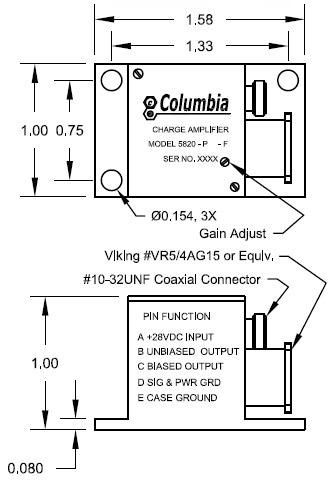The Series 5820 Charge Amplifiers from Columbia are specifically developed for use with virtually all piezoelectric transducers to develop several airborne vibration and shock data acquisition systems. Very small package size and extremely low power consumption are the features of these devices.
Series 5820 Charge Amplifiers offer dual signal outputs, one is biased about +2.50 VDC and one unbiased capacitance and the other one is unbiased capacitance coupled. They come in seven standard charge conversion ranges. Each range provides a 10:1 tandem gain adjustment capacity. It comes with a range of seven low-pass filters to fulfill the separate vibration measurement requirements of the users.
Note: Exports from the United States are subject to the licensing requirements of the Export Administration Regulations (EAR) and/or the International Traffic in Arms Regulations (ITAR).
- Biased or unbiased signal outputs
- Ultra-miniature electronic package
- 10:1, 20-Turn gain adjustment potentiometer
- Choice or Butterworth low-pass filter

Image Credit: Columbia Research Laboratories
Specification
Table 1. Source: Columbia Research Laboratories
| Electrical |
5820 |
| Input Source Resistance |
25 MΩ Min |
| Input Source Capacitance |
10000 pF Max. to meet all specifications |
| Overload Recovery |
5000 pcmb 1 mS Half-Sine, No Effect |
| Input Connection |
Single Ended, Referenced to Circuit Board |
| Output Impedance |
Biased: 100 Ω Max., Direct Coupled
Unbiased: 100 Ω Maximum, 22 uF Coupling Capacitor, 20 K Internal Load |
| Output DC Bias |
+2.500 +0.075 VDC @ Biased Output
0.000+0.050/-0.000 VDC @ Unbiased Output |
| Output Limiting |
Biased Output: +5.40 +0.20 VDC, 0 +0.05 VDC |
| DC Power Input |
+12 to +32 VDC, +28 VDC Nominal |
| Supply Current |
25 mA Max. |
| Minimum Linear Output Voltage |
4.65V Pk/Pk (1.64 VRMS) |
| Maximum Linear Output Current |
0.500 mA Pk/Pk |
| Frequency Response |
+5%, 5 Hz to 10 kHz Available (Refer to Filter Chart) |
| Residual Noise |
5.0 mV RMS Max |
| Amplitude Linearity |
1% Max.B.F.S.L. |
| Gain Stability |
Temperature:+2% Max over Operating Temperature
Input Capacity: <0.10%/1000pF |
| Total Harmonic Distortion |
1% Max. |
| Warm-up Time |
30 Seconds Max. |
| Case Ground Isolation |
Circuitry Isolated by 50 MΩ Min. @ 50 VDC |
| Environmental |
5820 |
| Temperature, Operating |
-55 to +85 °C |
| Temperature, Storage |
-55 to +125 °C |
| Vibration |
20 G PK from 50 Hz to 2 kHz |
| Shock |
100 G PK with 6.5 mS Sawtooth pulse |
| Humidity |
Hermetic Grade Epoxy Seal |
| Altitude |
200,000 Ft Max. |
| Physical |
5820 |
| Weight |
50 gms Max. |
| Size |
1.575" L x 1.00" W x 1.00" H
(4 cm L x 2.5 cm W x 2.5 cm H) |
| Case Material |
Aluminum |
| Electrical Interface |
Output: Viking VR5-4AG15, 5-Pin Cylindrical
Input: Double Insulated #10-32 Coaxial |
| Case Mounting |
(3) #6 Thru Holes for #6-32 Socket Head Cap Screw |
Standard Gain Ranges
Table 2. Source: Columbia Research Laboratories
| SUFFIX |
CONVERSION GAIN RANGE |
| P1 |
0.2 TO 2.0 mV/pcmb |
| P2 |
0.5 TO 5.0 mV/pcmb |
| P3 |
1.0 TO 10.0 mV/pcmb |
| P4 |
2.0 TO 20.0 mV/pcmb |
| P5 |
5.0 TO 50.0 mV/pcmb |
| P6 |
10.0 TO 100.0 mV/pcmb |
Low-pass Filters
Table 3. Source: Columbia Research Laboratories
| SUFFIX |
±5% RESPONSE |
ROLLOFF |
| Fl |
5 Hz TO 10 0Hz |
-12 dB/OCT |
| F2 |
5 Hz TO 200 Hz |
-12 dB/OCT |
| F3 |
5 Hz TO 500 Hz |
-12 dB/OCT |
| F4 |
5 Hz TO 1000 Hz |
-12 dB/OCT |
| F5 |
5 Hz TO 2000 Hz |
-12 dB/OCT |
| F6 |
5 Hz TO 5000 Hz |
-12 dB/OCT |
| F7 |
5 Hz TO 10000 Hz |
-12 dB/OCT |